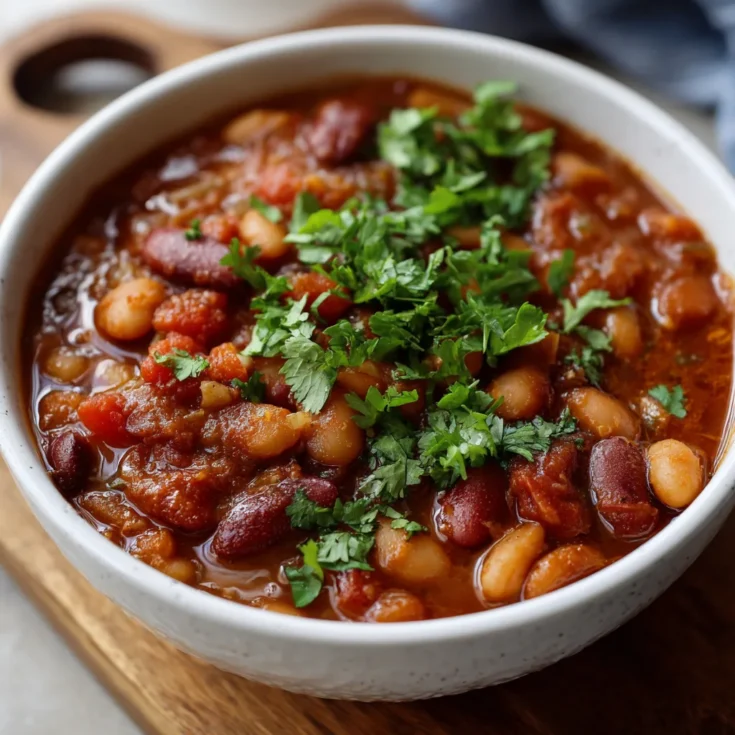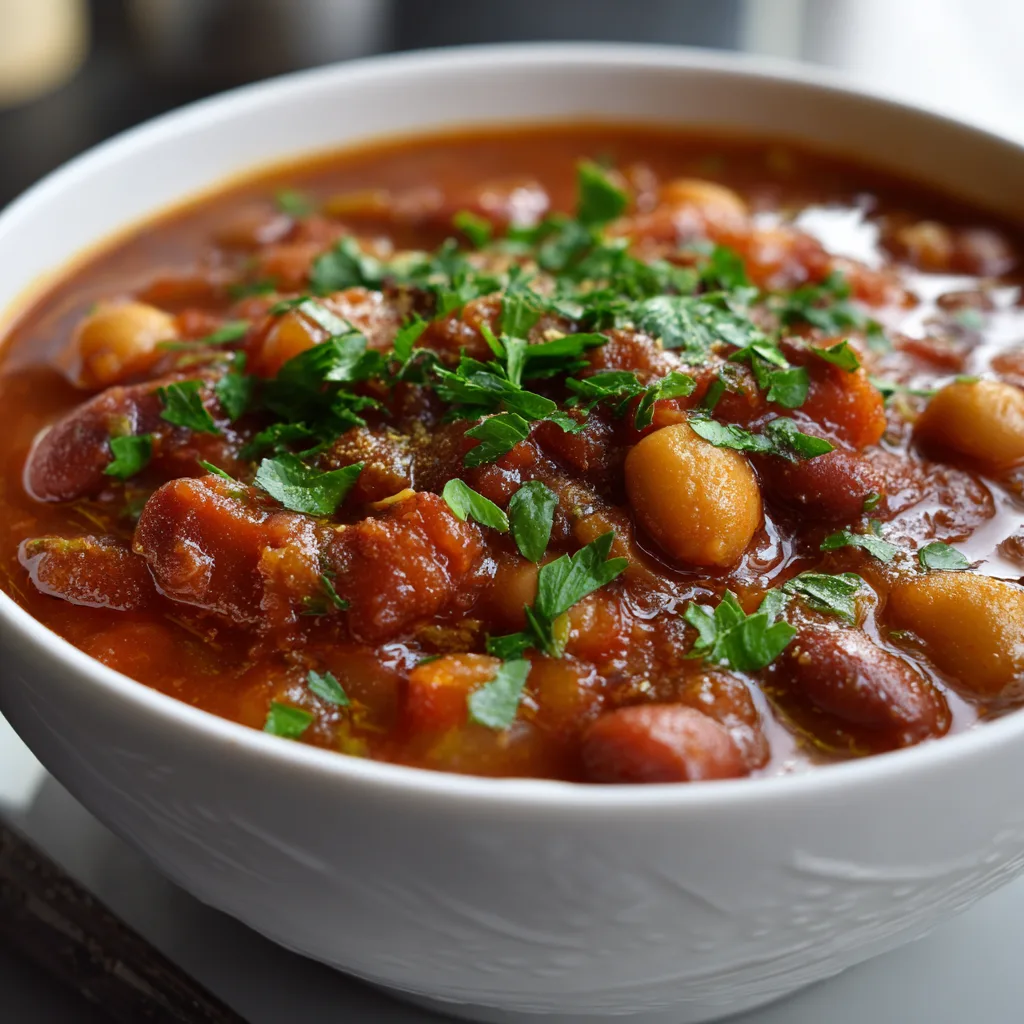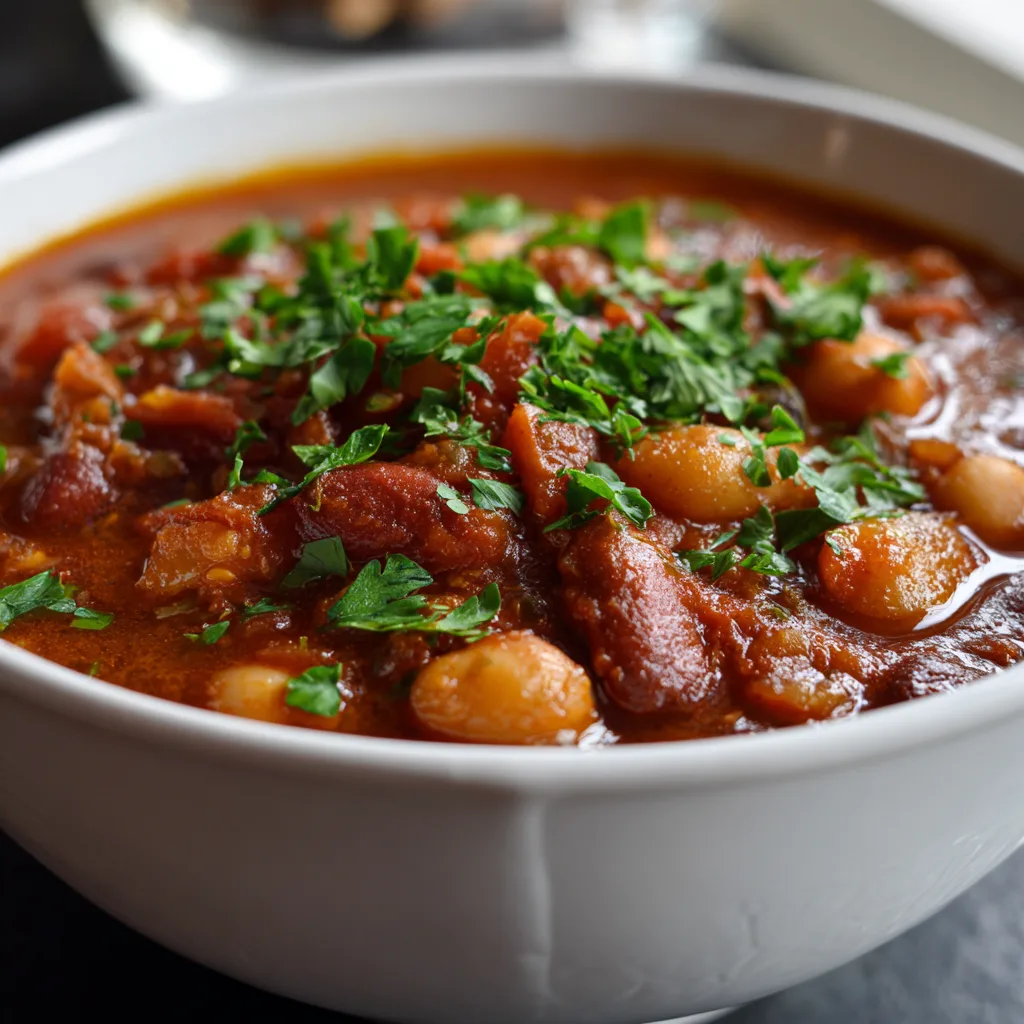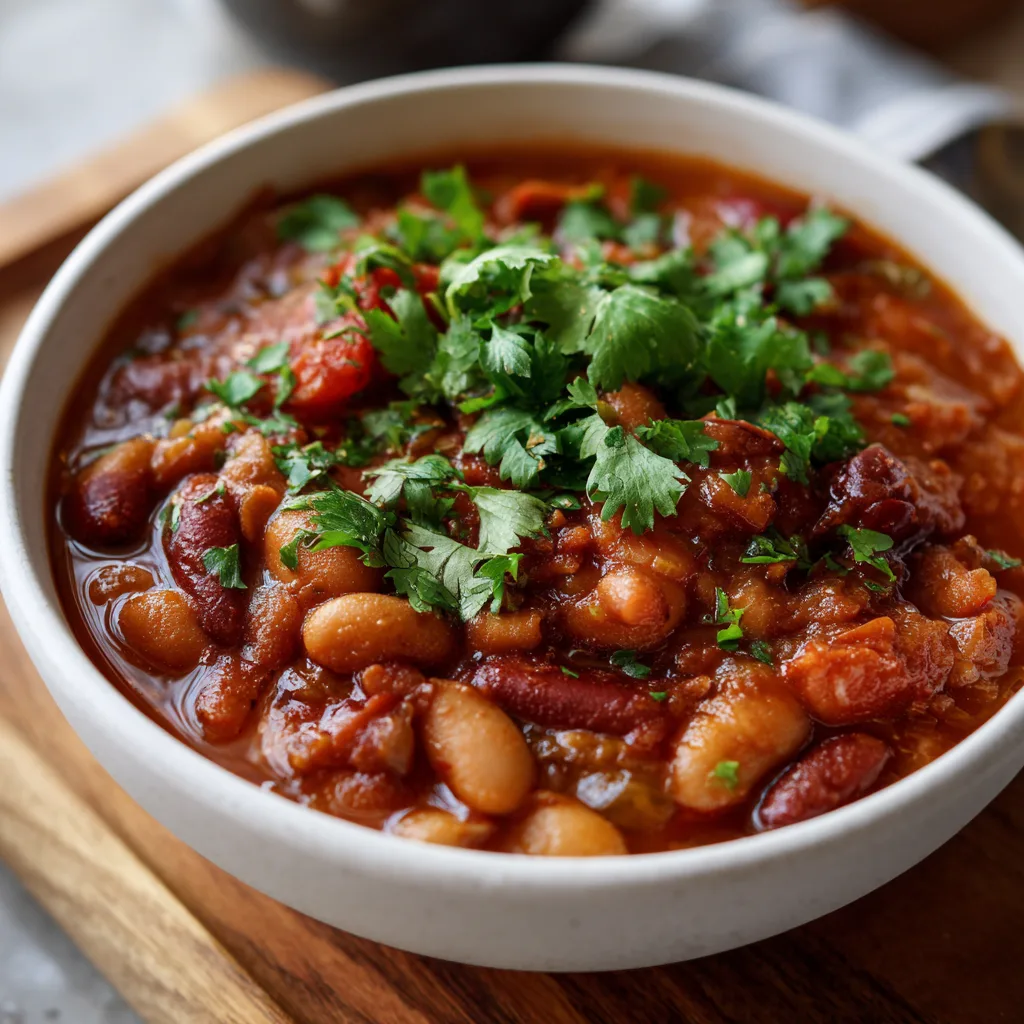Easy Crockpot Beans Stew — The Ultimate Make‑Ahead Comfort Meal
Crockpot bean stew is the kind of meal that welcomes you home with warmth and comfort. It simmers quietly while you focus on your day, releasing deep, savory aromas that hint at the hearty goodness inside. Using a slow cooker takes the stress out of cooking. You toss everything in, set the timer, and let it work its magic—no hovering required.
This dish blends flavor, nutrition, and convenience in one pot. Beans provide rich plant-based protein and fiber, making the stew naturally filling and satisfying. It’s a smart solution for busy families, meal preppers, or anyone craving a wholesome dinner with minimal cleanup. Best of all, you can customize it—go fully vegetarian, or stir in a bit of meat for added depth. It’s flexible, affordable, and always nourishing.
With just a few simple ingredients and a slow cooker, you can create a deeply flavorful dish that feels like a warm hug in a bowl.
What Is Crockpot Bean Stew?
Crockpot bean stew is a thick, rustic dish made by slow-cooking beans, vegetables, and spices until they become rich and tender. Unlike soup, which is broth-heavy, stew has a denser texture and heartier bite. This stew isn’t just filling—it’s also full of personality, thanks to the variety of beans and regional flavors you can include.
Different cultures have their own takes on bean stew. Moroccan Loubia features white beans simmered in tomatoes, garlic, and cumin. In Italy, Tuscan white bean stew combines creamy cannellini beans with herbs and leafy greens. Each version reflects the soul of its cuisine, while the crockpot makes it easier than ever to bring those global flavors into your own kitchen.
Choosing Your Beans: Best Types for Crockpot Bean Stew
When building a rich, flavorful crockpot bean stew, the beans you choose form the foundation. Dried beans are more affordable and absorb flavor better, but they need soaking overnight or a quick boil-and-sit method. This extra prep pays off with better texture and less sodium. On the other hand, canned beans are convenient and still delicious—just be sure to rinse them well to reduce salt.
Choose beans that hold shape and flavor. White beans, navy beans, or great northern beans offer a mild base with a creamy finish. Black beans and pinto beans bring bold, earthy notes. For variety, try a seven-bean mix or heirloom blends. These combinations not only look beautiful but also offer different textures in every spoonful. No matter the type, beans transform into something deeply satisfying when slow-cooked with care.
Broth or Water? Choosing the Best Liquid Base for Bean Stew
The liquid you choose impacts every bite of your crockpot beans stew. Vegetable broth or chicken broth adds immediate flavor depth. It infuses beans with subtle herbs, roasted notes, and extra richness. If you’re using a salted broth, adjust your seasoning toward the end of cooking to avoid overdoing it.
Water is a clean, neutral option. It allows the natural flavors of beans, vegetables, and spices to shine. If you use water, bump up the aromatics—add more onion, garlic, and herbs for balance. Some home cooks also blend water with bouillon for a budget-friendly middle ground.
The choice between broth vs water often depends on your goals: budget, flavor, or dietary needs. For a lighter dish, go with water and plenty of herbs. For a deeper, more savory base, broth is your best friend.
Vegetarian or Meaty: Customizing Your Crockpot Bean Stew
Crockpot bean stew is naturally flexible. If you want to keep it vegetarian, build richness with olive oil, onions, garlic, and a mix of herbs like thyme, oregano, and rosemary. Leafy greens such as Swiss chard or kale add texture and nutrients.
Want something meatier? Try adding sliced sausage, ham hock, or beef stew meat. These options create layers of smoky or savory flavors that seep into the beans during the slow cook. Stir them in at the start so they soften and release their juices. For balance, pair meat with acidic ingredients like tomatoes or vinegar toward the end.
Boosting Flavor: Spices and Add‑Ins That Make a Difference
Spices can elevate crockpot bean stew from basic to bold. Start with the basics: onion, garlic, paprika, and black pepper. Then, build complexity with thyme, rosemary, or a pinch of oregano.
For a global twist, infuse Moroccan flavor using ground cumin, ginger, and a touch of cayenne pepper—perfect for a version inspired by Loubia. Want smokiness? Try smoked paprika or chipotle powder. For warmth and depth, a bay leaf works wonders.
Whether you’re going classic or adventurous, spices and herbs unlock the soul of your stew. Always season gradually, and taste just before serving for balance.
Prepping the Beans: Soaking for Better Stew Results
When working with dried beans, preparation matters. Soaking beans overnight softens their texture, reduces cooking time, and makes them easier to digest. Simply cover them with water and let them rest for 8–12 hours. If you’re short on time, use a quick soak: boil the beans for 2 minutes, turn off the heat, and soak for 1 hour.
While no-soak cooking is possible, it requires longer crockpot hours and may result in firmer beans. Certain beans—especially kidney beans and cannellini—contain lectins, which can be toxic if not cooked properly. To stay safe, always boil red kidney beans for at least 10 minutes before slow cooking. This neutralizes harmful compounds and ensures your stew is both safe and delicious.
Rinsing canned beans is essential too—it reduces excess salt and helps remove the canning liquid, giving your stew a cleaner flavor.
Layering Ingredients in the Crockpot: Building Flavor with Every Step
The way you layer ingredients in your crockpot affects both cooking and flavor. Start by placing the beans at the bottom—they take longest to cook and need direct heat. Next, pour in your liquid base, whether broth or water. This prevents the beans from drying out and helps distribute heat evenly.
Add aromatics like onions, garlic, and herbs next. Their flavors will infuse the liquid during the long cook. If you’re using meat, layer it on top of the beans so its juices flow down. Vegetables like carrots, bell peppers, and tomatoes can go last—they’re softer and require less time.
Avoid stirring at the beginning. Let the crockpot do its job. Once the stew simmers down, give it a gentle stir to unify flavors without breaking the beans.
Cooking Time & Temperature: Getting It Just Right
Your crockpot settings make a big difference in the final dish. For the best texture, slow and low is the way to go. Cook on low for 7–8 hours for deep flavor and tender beans. This setting works best for dried beans, as it gives them ample time to soften.
Need it faster? Cook on high for 4–5 hours, especially if you’re using canned beans or pre-soaked dried ones. However, high heat can make beans mushy if left too long. Always check beans for doneness—they should be tender but still hold their shape.
Avoid opening the lid too often. Every peek releases heat and slows down cooking by 15–20 minutes. Trust the process. If you’re unsure about timing, test a bean between your fingers or take a small bite—done beans are soft, not chalky.
Thickening and Texture: Achieve the Perfect Stew Consistency
Want a thicker stew? Use a potato masher to crush some beans directly in the crockpot. This adds creaminess without extra ingredients. For a smoother texture, blend a portion with an immersion blender—but leave enough whole beans for body.
To avoid overcooking greens, stir in leafy vegetables like kale or Swiss chard during the last 15 minutes. They retain color, texture, and nutrients when added at the end. This simple trick keeps your stew bright and balanced.
Make‑Ahead, Freezing & Storage: Smart Batch Cooking Tips
Crockpot bean stew stores well. Refrigerate leftovers in airtight containers for up to 5 days. For longer storage, freeze in single portions for up to 3 months. Defrost overnight in the fridge and reheat gently on the stove or microwave, adding a splash of water if needed.
Global Styles of Slow Cooker Bean Stew
Bean stew takes on deliciously unique forms across the world, and your crockpot adapts to them all.
Moroccan Loubia is a bold North African classic that simmers white beans in a sauce of cumin, garlic, tomatoes, and sometimes grated onion. It’s aromatic and spicy, with a warming depth ideal for cold evenings. Add a pinch of ginger or cayenne for even more kick.
In contrast, the Tuscan bean stew, also known as ribollita or zuppa Toscana, leans into comfort with Italian herbs, rich olive oil, and optional sausages. Often made with cannellini beans and dark leafy greens, this variation balances savory with fresh.
For a vegetarian option, try a white bean and Swiss chard stew. This version combines tender beans with silky greens and vegetable broth. It’s gentle, nourishing, and packed with fiber.
Creative spins include the three-bean cocoa stew, adding cocoa powder for richness, pinto bean and ham stew for Southern flavor, or the seven-bean medley—a mix of textures and colors that’s hearty and eye-catching.
No matter the region, bean stew adapts beautifully to local ingredients and spice palettes.
Serving Suggestions & Pairings
Pair your crockpot bean stew with crusty whole grain bread, buttery cornbread, or a scoop of brown rice for a complete meal. These options soak up the flavorful broth and add satisfying texture.
For toppings, a sprinkle of chopped parsley or cilantro adds brightness. For richness, try grated cheddar, a dollop of sour cream, or a drizzle of olive oil. Even avocado slices or toasted pumpkin seeds make tasty, textural garnishes.
Stew also works well as a filling—use it in baked potatoes, stuffed peppers, or flatbreads for something more adventurous.
Nutritional & Dietary Notes
Crockpot bean stew is naturally high in fiber and loaded with plant-based protein, making it perfect for anyone seeking balanced, meat-free meals. Most versions are also gluten-free, depending on the broth and add-ins.
To keep things vegetarian or vegan, use vegetable broth and skip meat-based flavorings. Add umami through mushrooms, miso, or smoked paprika. If you’re watching sodium, opt for low-sodium beans and broth, and season with herbs instead of salt.
With endless ways to customize and a solid nutritional profile, this stew fits into almost any eating plan—from clean eating and Mediterranean diets to plant-based and low-fat lifestyles.
Frequently Asked Questions About Crockpot Bean Stew
Do I need to soak dry beans before using a crockpot?
Soaking beans is optional but helpful. Overnight soaking shortens cooking time and improves digestibility. However, if you skip soaking, cook the stew longer—typically 8–10 hours on low. Always boil red kidney beans for at least 10 minutes before slow cooking to remove lectins, which can cause digestive upset. Soaked or not, dried beans work beautifully in a crockpot.
Can I use broth instead of water? Does it matter?
Absolutely. Using vegetable or chicken broth enhances the flavor and gives your stew more depth. Just remember, broth adds extra salt, so adjust seasoning accordingly. If you’re using low-sodium broth, you get all the taste with better control over saltiness. Water works fine too, especially when paired with rich herbs and spices.
Can I add meat like sausage or ham?
Yes—adding sausage, ham, or beef stew meat boosts richness and turns the dish into a full meal. Brown meat before adding it to the crockpot for deeper flavor. Add sausage slices or ham hocks early in the cooking process so they can tenderize and season the beans. For shredded meat, add it in the final hour to avoid overcooking.
How do I thicken the stew and avoid watery soup?
To create a thicker stew, mash a portion of the beans directly in the crockpot. This naturally thickens the broth. Another option is to stir in starchy vegetables like potatoes. If the stew is too soupy, remove the lid for the last 30 minutes of cooking. That allows excess liquid to evaporate.
Is this stew freezer-friendly? How long does it last?
Yes—this stew freezes and reheats well. Store cooled leftovers in airtight containers in the fridge for up to 5 days or freeze for up to 3 months. For easy reheating, portion it out before freezing. When ready to eat, thaw in the fridge overnight, then warm on the stovetop or in the microwave with a splash of broth or water.
Easy Crockpot Beans Stew – Simple, Hearty & Budget-Friendly

Hearty, flavorful bean stew made in the crockpot with minimal prep
Ingredients
- 1 lb dried beans (e.g., navy, great northern, or mixed) or 4 cans (drained)
- 1 onion, chopped
- 2–3 carrots, diced
- 2 stalks celery, chopped
- 3–4 cloves garlic, minced
- 1 (14‑oz) can diced tomatoes
- 6 cups water or broth
- 1 tsp dried thyme, rosemary, or oregano (or cumin/paprika for Moroccan flavor)
- Optional: sausage, ham hock, or stew meat
- Salt and pepper to taste
- Optional leafy greens (kale or Swiss chard), added at the end
Instructions
▢ Rinse and soak beans overnight (skip if using canned)
▢ Add beans, chopped vegetables, garlic, tomatoes, spices, and broth/water to crockpot
▢ Stir everything; cover and cook on LOW 6–8 h or HIGH 4–5 h
▢ (Optional) Add meat at beginning or halfway; stir in greens ~15 minutes before end
▢ Taste, adjust seasoning; mash a few beans for a thicker stew
▢ Serve hot with bread, rice, or cornbread
Notes




